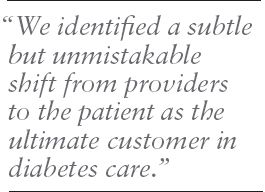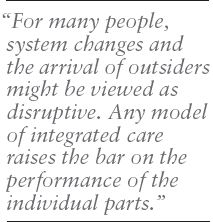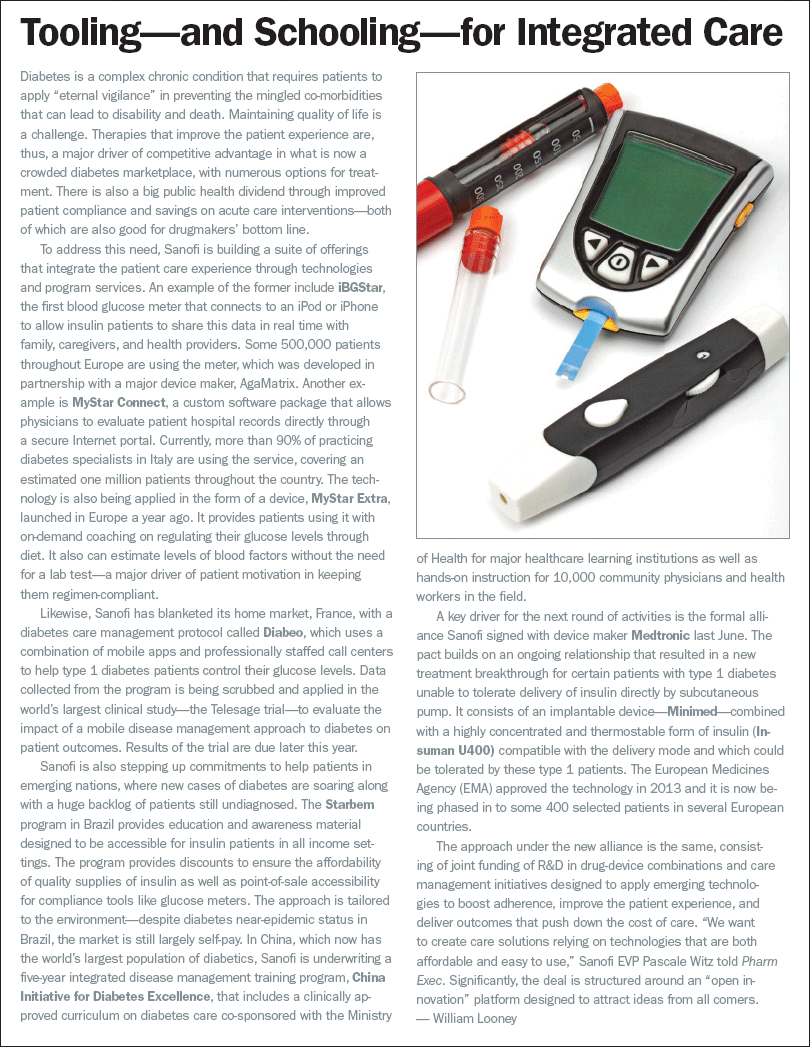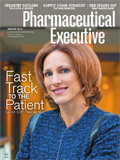Sanofi’s Big Bet on Integrated Patient Care
Pharm Exec profiles Sanofi EVP Pascale Witz, tagged with the assignment to move a lumbering biopharma giant closer to the embrace of the patient perspective in healthcare.
"Reinvention" may be the management buzzword of choice for today's big Pharma players, yet it's still hard to find c-suite leaders with the strategic chops-and specific job description-to make it happen. France's Sanofi, seeking to transition from a deep-rooted legacy operation whose family tree could supply a writer with paper for decades, is the exception. To become a globally integrated biopharmaceuticals enterprise, with a drug pipeline now 80% focused on next-generation biologics, Sanofi knew it had to rewrite history-and become a different company.
The precise contours of this change remain a work in progress. But in July 2013, then CEO Chris Viehbacher took a decisive first step toward reinvention, splitting the commercial organization into two units and creating a new executive level position responsible for setting strategies to drive product development, coordinate launch cycles, and deliver P&L for the pharma businesses' innovative growth platforms, including the all-important diabetes franchise, oncology, immuno-inflammation, cardiovascular disease (CVD), and consumer OTC. The remit also expanded the footprint of Sanofi Patient Solutions, which provides customized service and delivery innovations "beyond the pill," but which to date has focused on diabetes care.

Significantly, the job went to an outsider: Pascale Witz, a 17-year veteran of General Electric (GE) who led its global medical diagnostics business. Witz, 48, an MBA graduate of France's top private business school, INSEAD, stood out for her grounding in GE's strong cross-disciplinary culture. Another draw was GE's track record in shortening product development cycles-historically a lagging indicator of efficiency in big Pharma. Through her efforts to reposition diagnostics as a value driver in patient outcomes, Witz was familiar with the difficulties of obtaining reimbursement for new technologies in an era of declining health budgets. And there was her youthful, pre-career status as a top track and field athlete, a distinctly unconventional route for female achievement in France-but more on that later.
Clout with consequence
Witz says she took the job for two reasons. First, the P&L responsibility put her in the management big league, with a portfolio of more than €15 billion in annual sales. Second, it offered the opportunity to execute around a new business model just as the company's drug pipeline was nearing prime time. As was the case at GE, Sanofi was generating good science that, in addition to offering patients radically new options for treatment, posed some challenges to the traditional way in which medicines were developed, dispensed, and used in the healthcare system.
Internally, questions arose on whether changes in Sanofi's R&D operation were testing the relevance of the standard playbook used to guide the path to commercialization. Under R&D chief Elias Zerhouni, drug development had been restructured around a more flexible, outward-facing model of collaboration, one that recognizes today's biological disease targets are too complex and costly to be solved by any one stakeholder. The number of interests engaged to support the science demanded constant consultation and feedback, particularly in rendering judgments about whether investments in novel, cutting-edge therapies would find favor in a changing market, years down the line.
This meant that teams associated with transitioning a compound to launch and then thrive in the real world marketplace needed to be sourced in tandem with the science, not kept in silos. Yet conversations with those responsible for the clinical development and launch teams often failed to incorporate the growing diversity of players with an impact on take-up of a new drug.

High stakes pipeline
A sense of urgency helped accelerate the push to reinvent. Like its big Pharma peers, Sanofi has been hit with a wave of patent expirations over the past few years, led by the loss of exclusivity of its anti-coagulant blockbuster, Plavix, in 2013. More important, the US patent on Sanofi's top-selling diabetes drug, Lantus, is due to expire next month, creating another deep hole in revenues. To rebuild its product line, Sanofi intends to launch as many as 18 new drugs and vaccines medicines (10 are in late-stage development) between now and 2020-a pledge it reaffirmed at its annual investor conference in Boston in November. Witz points out that achieving this goal means rolling out a new medicine virtually every six months.
"By the time I arrived at Sanofi in July 2013, one thing was clear. The days of developing a medicine purely on the basis of clinical efficacy and then handing everything over to sales with the three-word command "sell, sell, sell" are over," Witz told Pharm Exec. "What was required is a stepped-up commitment to focus all our resources to address a single question: do our efforts support a real medical need, across the broad continuum of care, with the potential to carry a positive impact on outcomes, as defined by the patient? It's a tough question, because with the healthcare environment changing so quickly, it had become unclear just who our customers are."
In addition, many of the new products Sanofi plans to introduce address chronic illnesses, where market success depends on a high level of patient motivation and engagement. Says Witz, "Sanofi's unique product mix requires that we deal with people who have to manage their condition for the long term-literally, they must use our medicines for the remainder of their lives. So, the issue of how we get closer to the patient is not an academic exercise for us. Could we make an impact on outcomes by helping patients better understand the best way to manage their disease?"
Disease-first integration
Witz decided that her first task as Sanofi's newest EVP would be to resolve these questions-decisively-with diabetes tagged as the "change agent" for a new business model built around a more integrated approach to care. Diabetes was an obvious choice, not only because it occupied prime turf as the company's biggest therapeutic franchise, where Sanofi had decades of expertise, but also because, like it or not, changing market conditions required a different approach. The diabetes segment has multiple players, is brutally competitive, and is buffeted by frequent modest improvements in science (there is still no cure in sight) that have companies vying to position their drugs as the foundation therapy that patients can rely on in maintaining the highest quality of life.
With significant clinical differentiation harder to demonstrate, the conveniences a new diabetes drug offers to patients, particularly in promoting increased adherence-which has added appeal to prescribers and payers-can go far in determining whether a company hits blockbuster pay dirt or finds itself left in the dust. Add-ons like that will play an even larger role with the impending arrival of cheaper biosimilar versions of branded medicines like Sanofi's basal insulin Lantus, the company's top selling product, with sales of $7 billion in 2013. In fact, price pressures on the segment are looming large as an expensive new class of drugs, sodium-glucose cotransporter 2 (SGLT2) inhibitors, which reduce blood sugar through pills taken orally, albeit with monitoring for side-effects, come forward to the market.
In other words, "value" is the trump card in diabetes care, today and tomorrow. And who is the most important determinant of that value? According to Witz, it is the patient. "We identified a subtle but unmistakable shift from providers to the patient as the ultimate customer in diabetes care." Behind that determination were many of the factors outlined earlier-competition, cost, cures, and compliance, not to mention expectations: as the incidence of diabetes worldwide reaches the 400 million mark, with another 179 million people estimated as undiagnosed, and with treatment consuming 11% of global health costs, the challenges posed by this disease are too large to be devolved to a professional elite-there is no other choice but to put the patient in charge of managing his own condition.
As part of a strategic business review, Witz and her team brought patients and representative groups to the company to get input on everything from the experiences of family care givers; injection phobias (what's worse: the belly jab or the finger prick?); risk exposures, like the side-effect trade-offs from new oral versions of insulin; and the consumer appeal of miniaturized glucose monitoring devices. Everyone was exposed to the dialogue, right up to Sanofi's executive committee, including the CEO, CFO, and the global leads on R&D and manufacturing.

Leading with diabetes
The outreach yielded several insights that Witz promptly adopted as a learning tool. One was the sheer range of ideas and options brought forward, which raised the prospect of a dispersed, unfocused effort that would produce only marginal improvements against the status quo. To avoid this, Witz opted to proceed on a step-by-step basis, addressing the "pain points" revealed through the patient contacts first. "We convened our teams responsible for clinical development, commercialization, logistics, product support, and market analytics-each a lead in diabetes, but with different functional expertise-to decide what might really make a difference in how patients handle their condition on a day-to-day basis. I posed it not as a one-off exercise but as a relentless, ongoing challenge: rewiring our thought processes to consider even the most minor things from the patient's standpoint."
One pain point was the failure of drugs and devices to interact in a way that minimized the time and management burden of keeping blood sugar within prescribed range. Says Witz, "That finding persuaded us to start looking at better drug-device combinations, including miniaturized solutions around injections but also different tools to monitor glucose levels and how both can fit together to provide patients with an easier regimen they can manage almost without thinking."
Looking through the patient lens also puts a much stronger focus on the biggest drain on drugmaker revenues in diabetes care: adherence to therapy. More than half of patients on drugs or insulin fall off the wagon at some point, a proven data point that has serious public health consequences. "From the patient perspective, we can produce a great new drug, but if it's not designed to ease their burden of care then it leads to only one result: lower adherence and a poorer health outcome, for the patient and society," says Witz. "A development process focused on the patient directs us to create not just a great drug, but a well-designed solution-a solution that allows the patient to act on his own to comply to therapy."
Changing cultures
A second insight Witz drew from the consultations was how patient centricity could drive the larger cultural changes that Sanofi needed to cement its reinvention from a collection of older legacy businesses, with no sum to its parts, to a global innovator in the new science of biopharmaceuticals, vaccines, and consumer health. "Going from a focus solely on the medicine and how we push it to providers, to a focus on the disease and how can we make and deliver that medicine to achieve something of larger benefit to patients-it's more than just a shift in approach," says Witz. "There is a greater sense of purpose, involving input from more people, encouraging the cross flow of ideas and-most important-establishing objectives that can be shared, each of which contributes to a stronger bond among colleagues and, thus, better decisions from the team. The word that defines this process is engagement, which is what every company wants from its workers today."
And Witz notes that this cultural change dividend will pay out in other therapeutic areas, beyond diabetes, important to the company as well. "The shift to integrated care will only be transformational if it is systemic."
A final insight for Witz involved getting the organization prepared to accept change. Here, the approach Witz took was twofold.
First, she used her hiring power to bring in leaders from outside the industry to take a critical look at standard procedures, pose "out of the box" questions that hadn't been asked before, and help transfer best practices. The aim was to create additional channels of product and service expertise to connect to the regular drug development and commercial staff but not be dominated by them.
Looking outside
Specifically, Witz looked for people from businesses adjacent to pharma, like devices and diagnostics; people comfortable with digital connectivity, big data, and new information technologies, or with special skills in logistics and engineering, each with abilities to apply that to integrated care; and those with a combined exposure to big Pharma as well as more entrepreneurial start-up operations. "Several people I brought to Sanofi have a strong bearing in retail management, including my head of marketing, Jack Smith, who comes from the fast-moving consumer field and also worked for a key payer. Likewise, our new head of global analytics and market research, Michael Schwartz, joined us from Avon Products, which has intimate knowledge of customer motivation written into its DNA."
Second, Witz leveraged the cross-functional convening power that stemmed from her P&L operational responsibility over multiple disease areas. "It has to be acknowledged that, for many people, system changes and the arrival of outsiders might be viewed as disruptive. Certainly, any model of integrated care raises the bar on the performance of the individual parts. I realized I had to apply my operational mandate to overcome organizational inertia, allow all voices to be heard and drive the process forward."
Witz also anticipated there might be risks anytime a large organization ventures outside its marked zone of competence. "It's vital that someone at the top is there to give the teams the backing and, thus, the self-confidence to render a good decision, in the best interest of the whole company. I and other members of the senior executive committee reporting to the CEO filled that role. That's why I see one of my biggest achievements to date is simply to elevate the importance of the issue – giving people with fresh ideas the room to succeed."

Organizing for excellence
With these findings in mind, five Centers of Excellence (CoEs) have been established under the Global Divisions and Strategic Development umbrella to seed cross-functional collaboration and shift Sanofi's focus from pills to the patient. It's a matrix model that makes the CoEs the engine that run across the business segments, geographies, and support functions. The stated mission of each CoE is to "enable, orchestrate, and catalyze new thinking" through the application of integrated care approaches that transfer knowledge from one disease area to another. All report in to Witz.
The CoEs with the highest profiles are Integrated Care and Patient Centricity. Integrated Care is led by Paul Sekhri, a former head of strategy for Teva, the major player in generics worldwide. His group coordinates company-wide health solutions-based approaches to treatment in key therapeutic areas, including diabetes and CVD. Integrated Care also administers a series of country-level projects (see sidebar) to help diabetes patients manage their condition through data analytics and other technologies. Anchoring this effort is an alliance partnership agreed last June between Sanofi and Minneapolis-based Medtronic, a leading device maker, on drug-device combinations and programs to raise treatment compliance.

Tooling-and Schooling-for Integrated Care
An industry first
Patient Centricity is built around a new position of chief patient officer-the first such appointment in big Pharma-that Witz created in March 2014. It is held by Dr. Anne Beal, a physician and longtime US public health and patient advocate, who served previously as deputy director at the Patient-Centered Outcomes Research Institute (PCORI), an independent government-funded research institute authorized by Congress to study the clinical and social impact of health and pharmaceutical interventions on patients. In addition to building a comprehensive and globally consistent strategy on liaison with patient groups, Beal and her team work to incorporate the patient perspective at every stage of the product development and life cycle, from R&D proof of concept to post-marketing studies and reimbursement access. The mandate also includes special outreach to caregivers, an often neglected element of the patient community.
The other CoE's cover Marketing, with an emphasis on operational effectiveness; Market Access, which coordinates work on demonstrating value for money and advocating with regulatory and reimbursement authorities; and Global Strategic Development, which pursues investment opportunities around products and services that help advance the integrated care model. Witz cites marketing as a function where it suits to take a page from the fast-moving consumer business and interact with customers directly, in pace with changing market sentiment. "We are in a world now where you don't want to wait on the traditional focus group to give you that long-tail cycle of feedback. Instead, it should be a continuous loop. And you must have all the complementary functions behind a marketing plan to be sitting in one place, which is what we have done through the CoE."

Get data wise
Witz is a big believer in the use of data to build evidence around products and services. She relies on a simple strategic guidance that is communicated regularly to the development teams: "if one of our great solutions is not affordable to those who will use it, then there is no benefit to it-full stop." Of course, a special challenge to an integrated care model is the ability to show that the whole "solution" works better than its individual parts. This can be difficult because much of the health delivery infrastructure remains siloed. The solution, claims Witz, is reconsidering what kind of data companies collect, and to focus that effort more on demonstrating aggregate measures of outcome. "We can do a lot more with the data we have, particularly in performing a vital task in integrated care, which is benchmarking our performance against a host of known indicators, as well as many new ones. It's not only necessary to measure an outcome, we have to show the stakeholder how much our actions have influenced it. That's where analytics-the interpretive side of data-comes in."
2015: Prime time
Looking forward to 2015, Witz and her team will be prepping for US and EU regulatory approval and launch of Toujeo (trade name, pending approval), Sanofi's much-hyped injectable rDNA glargine insulin successor to Lantus. A final decision from both the FDA and EMA is likely by no later than mid-year. Launch of Toujeo will include complementary integrated care protocols to educate clinicians and help patients transition from Lantus, all of which have been designed from the patient standpoint. Assets that can be coached to patients and their physician include clinically established evidence that Toujeo is longer lasting, with a 24-hour effect, and does not promote weight gain; more important, it does a better job than Lantus in stabilizing blood sugar levels, particularly at night, when the incidence of hypoglycemia poses more danger to patients.
This year will also see introduction of Sanofi's licensed-in inhalable insulin, Afrezza, which it will co-promote with the device's developer, MannKind. The aim is to target new diabetes patients skittish about injecting as well as those whose insulin deficiency has progressed to the point where additional jabs are needed. "Sanofi took on the marketing of this product because it reinforces our commitment to see things from the patient's point of view: it's a non-invasive therapy that provides an additional option for them in care delivery," says Witz. One big hurdle, however, is the FDA requirement that users undergo pulmonary function tests to ensure Afrezza's short-acting insulin does not damage lung tissue. It may be hard to put a patient friendly gloss on that.
More with Medtronic
Witz is personally excited about the new alliance with Medtronic and its open innovation model of discovery. That's because, in the absence of a cure, a technology that can ease or simplify any episode of care in the patient journey has to be framed as a victory-not only for the enabling technology, but for the drug, too. While the partnership is likely to evolve in a number of different ways, Witz touts the level of ambition in this deal. "The mandate Medtronic CEO Omar Ishrak and I gave to the alliance team is to imagine a patient who, instead of having to think about her diabetes 24 hours a day, seven days a week, could just stick a device on her arm and forget about the disease until the following week. We hear from every patient that what's worst about being a diabetic is there is never a day off."
Analysts note that Medtronic is in final testing stage for a device that might do just that. Guardian Mobile, a continuous glucose monitor, Bluetooth-enabled in the form of a mobile app, is designed to eliminate the burden of daily pinpricks and alert the user to his individualized glucose level thresholds without him doing anything but pressing "start" on his smart phone.
Beyond the diabetes model-next?
Another responsibility facing the new division is building support for perhaps the most promising drug in Sanofi's pipeline. Alirocumab is a monoclonal antibody of the proprotein convertase subtilisin/kexin type 9 (PCSK9) class that in successive clinical trials has shown a high level of efficacy in lowering LDL among patients symptomatic of uncontrollable cholesterol, a leading factor behind the world's number one killer, CVD. Alirocumab also presents fewer of the lethal side-effects that have hampered progress in next-generation lipid lowering agents. The compound is the outgrowth of a R&D partnership with Regeneron that dates back to 2007. The new class of PCSK9 antibodies has attracted the interest of other big Pharma competitors, so prospects for alirocumab (trade name Praluent, pending approval) depends on expediting a path to FDA approval and reaching patients before others do.
In fact, assuming the FDA gives final assent later this year, this new therapy could serve as the biggest test of the Witz strategic lesson plan. That's because cholesterol management matches diabetes in demanding high-level patient engagement and compliance. Alirocumab, as a biologic drug, will be administered by injection, where of course there are many precedents from the diabetes space that Witz and her cross-functional teams can draw on. One item under development is an auto-injector device that hopefully cholesterol patients will find tolerable and convenient to use. In addition, the development team for alirocumab has recruited a colleague from Sanofi's consumer business to fill a new position, head of patients' insight.
Priority of three
Summing up, Witz knows that all eyes are on the estimated €30 billion plus of added revenue that Sanofi expects to come from new products in the next five years. Knowing as well that her assignment is transcendent-essentially boundaryless-Witz expects to have first-line accountability for results, particularly around the launch cycle of as many as 10 new medicines. In the course of our interviews, she shared with Pharm Exec three goals:
» Achieve the financial and budget targets linked to increased P&L performance.
» Build and meet process metrics for new product positioning and launch-covering strategy, readiness, execution, speed to timelines, and geographic scope and reach.
» Move the Sanofi culture decisively toward a patient-centered, solutions-driven model of integrated care.
Witz is confident that the resources and people required to accomplish these objectives are in place. But there is another capability to add to the mix-her personal history as a businesswoman and an athlete, both fields where men till all the turf that is prime. "I started out as champion in track and field's 400-meter hurdle race, which put me at the top of the league in a sport that had virtually no audience in France. I went to a regional university to major in molecular biology that also had a solid field sports curriculum; it was about as far as you could get from the traditional route to success through the "classes prepa" institutions in Paris."

The 400-meter life lesson
Witz says her early experience in track has taught her two invaluable life lessons. "First, there is virtue in excelling at an obscure sport. It offers the opportunity to test, fail, and work toward a goal without being sidetracked by all the distractions driven by other peoples' pretenses. Second, track is highly competitive. In the hurdles, you spend months of rigorous training all for a few seconds of intense effort-the season is short, but you work for a long time. "This," she continues, "is a neat grounding in the character traits that bring success in business-working close to the core; anticipating the end game; having mutual support from others, especially behind the scenes; together moving the baton in one direction, but where it can all end suddenly with just a single false step."
Being grounded is good-if only because it's easier to navigate those steps, one at a time. And while a reinvention can start at the top, it must build momentum from the base. Yes, it is true that rival companies share the premise behind this reinvention-it's become almost a cliché to say you want to get closer to patients-but Sanofi still stands out in placing most of its R&D bets on therapies that require high levels of patient compliance to succeed commercially. Will patients jump all those chronic care hurdles and help Witz and her team keep up the pace? The race is on.
William Looney is Pharmaceutical Executive's Editor-in-Chief. He can be reached at wlooney@advanstar.com.

The Misinformation Maze: Navigating Public Health in the Digital Age
March 11th 2025Jennifer Butler, chief commercial officer of Pleio, discusses misinformation's threat to public health, where patients are turning for trustworthy health information, the industry's pivot to peer-to-patient strategies to educate patients, and more.
Navigating Distrust: Pharma in the Age of Social Media
February 18th 2025Ian Baer, Founder and CEO of Sooth, discusses how the growing distrust in social media will impact industry marketing strategies and the relationships between pharmaceutical companies and the patients they aim to serve. He also explains dark social, how to combat misinformation, closing the trust gap, and more.
Applying Porter’s Five Forces to Portfolio Management in Pharmaceutical R&D: A Strategic Roadmap
March 17th 2025The increasing costs and complexity of R&D in the pharmaceutical industry have necessitated the adoption of strategic portfolio management to optimize resource allocation and enhance competitive advantage.